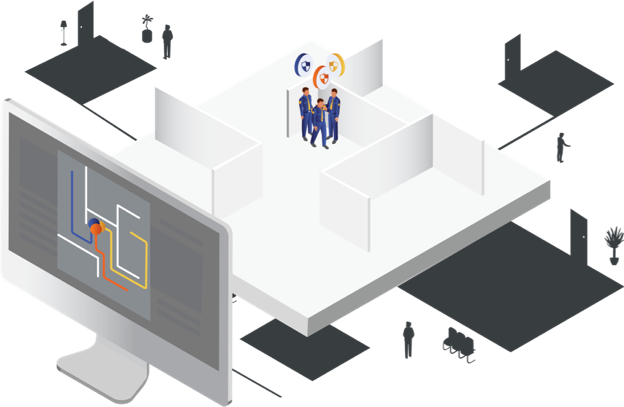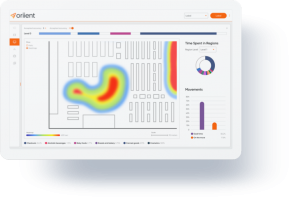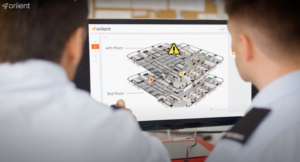Contact Tracing Inside Buildings via Smartphones
These days, contact tracing is a hot topic: how to manage it indoors, how to ensure accuracy, and how to make it safe. It is crucial for running malls, grocery stores, offices and campuses – and especially vital in hospitals, to protect frontline workers and patients from the spread of COVID-19.
“…one of the key priorities for testing is anyone who has been in close contact with someone who has tested positive. If you can get a list of these people quickly and make sure they are prioritized for a test…, then these people can isolate themselves before they infect other people. This is the ideal way of stopping the spread of the virus.”
Bill Gates, The first modern pandemic.
Currently, many countries are attempting to manage contact tracing through manual interviews of citizens who have tested positive for COVID-19. But this requires the patient to be able to accurately recall all the locations and people they’ve been in contact with for the past 2 weeks. For those of us who struggle to remember what we ate for breakfast on Tuesday, it’s difficult to give a sufficient, detailed picture of the past 2 weeks.
Other countries, like Israel, are using mobile phone triangulation to identify the comings and goings of infected persons, but unfortunately this doesn’t cover places with the biggest risk- indoor spaces.
If you can use GPS to identify the whereabouts of an infected person, but can’t determine exactly which areas of the facility they actually visited, that means everyone who visited the building is required to go into quarantine – even if they were on different sides of the building, and were never within proximity of a contaminated person. So how can you identify people’s locations indoors, where there is no GPS signal?
Some companies are offering contact tracing with wearables to achieve indoor positioning- but those often involve a hefty investment, in addition to costly bluetooth beacon installation throughout a facility.
State-of-the-art geomagnetic indoor positioning from Oriient provides a solution to safely, accurately and efficiently manage contact tracing indoors via user’s smartphones (and it comes with some added bonuses!).
Getting Started
Implementing an Indoor Positioning System is far less daunting than you’d think. Oriient’s hardware-free solution is set up quickly and ready for use in a matter of days – and extremely cost-effective (learn more about the process here). Integration to existing apps is a breeze via an SDK.
What’s required from you? Every visitor and employee just needs to have an app installed on their phone before entering the building – and keep their phones with them (which we all do anyway, right?). Simple, and convenient.
Analyzing Critical Data
Oriient Indoor GPS can collect data at an individual level, within 3ft/1 meter of accuracy, to ensure safety. To address privacy concerns, analysis of the individual data can only be processed in the case of a positive COVID-19 test.
Also, the activation of the tracking can be geo-fenced to your specific building, so no data will be collected by the app outside of it, or can even be set to only manually start recording upon a user’s command, and stop automatically as they leave the site.
Immediate, automated messages can be sent directly to the smartphone of those who have come into close contact or visited the same rooms or areas as infected persons, which saves a lot of time wasted on tracking down potentially infected people, during which they could be contaminating more people unknowingly.
In hospitals, contact tracing via indoor positioning has the ability to pinpoint precisely which doctors, nurses and staff have been at risk for contracting COVID-19, helping to avoid mass quarantines of vital workers at the time they’re needed most, while also protecting everyone in the facility.
Live Monitoring for Situational Awareness
Using an Indoor Positioning service allows for real-time monitoring as well as historical data on foot traffic. Monitoring is a must for safety, and it goes far beyond contact tracing alone:
- Real-time monitoring of pedestrian congestion indoors can help teams regulate and enforce social distancing measures – quickly and efficiently.
- Receive an up-to-date, accurate depiction of the number of people throughout your facility – allowing you to regulate the number of people inside any given area.
- Ensure that cleaning teams are able to adhere to new policies by keeping track of their daily routes.
Getting People Where They Need to Be – Faster.
A huge added bonus of deploying indoor positioning is real-time indoor navigation. It’s no secret that people struggle finding their ways in large buildings – but having people wandering your site, searching for where they should be only further increases risk for everyone else.
By providing the quickest and most direct route to a location within your space, you eliminate unnecessary wandering (and potential contamination), as well as help staff get where they need to be as quickly as possible.
Oriient’s Indoor GPS is the simplest, most cost-effective and accurate solution to better serve and protect staff and visitors inside any building.



